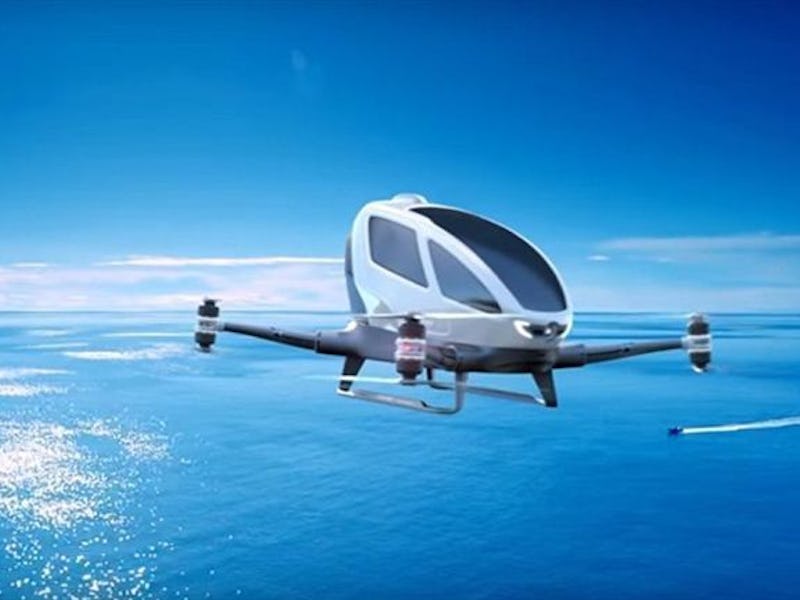10 Predictions For Flying Cars, and When They'll Happen
Flying cars are every commuter's dream.

Ever since the Jetsons burbled through the sky in saucer-like pods, commuting to work in a flying car has been part of the American dream of the future. But when are flying cars actually going to happen?
Some billionaire transportation magnates, like Tesla CEO Elon Musk, say that the whole concept is bunk (for what it’s worth, Stephen Colbert agrees). But that hasn’t stopped the other half of the tech world, like Google founders Sergey Brin and Larry Page, and a plethora of foreign companies and innovators from trying to put personal transportation in the skies. Here are ten predictions and milestones for keeping track of the casual commuter’s ascent to the skies.
Slovakia might be one of the first places to get a flying car.
Late 2017: AeroMobil’s light aircraft/car could fly over bad roads
Slovakia-based AeroMobil has been working on its flying car prototype for over 20 years. The idea is that it will let buyers in Eastern Europe just fly over bad infrastructure like broken roads, then touch down in urban centers and drive around like normal. The catch? No poors. The thing has a price tag of over $1 million. Also, it requires a pilot’s license.
Dubai might have personal drone taxis next month.
July 2017: Ehang flying drone taxis in Dubai
Dubai’s setting ambitious goals for flying cars, aiming to have a fully autonomous drone taxi — the Ehang-184 — in the skies in July 2017, or next month. The vehicle is basically a giant quadcopter with a tiny cockpit on it, that allows one passenger (who weighs less than 220 pounds) sit inside, plug in a destination on the screen, and sit back for the ride. Dubai has also literally promised jet packs though, so we’ll see if it happens in a few weeks.
Airbus's Vahana prototype.
Sometime in 2017: Airbus tests its “Vahana” Prototype
Airbus is also going for a vertical take off, or VTOL, model, and hopes to have a working prototype sometime in 2017. Many flying car companies see VTOL aircraft as the future, rather than more plane-based designs like AeroMobil’s, because they would be better at operating in tight urban areas.
Late 2018: Lilium regularly tests an all-electric VTOL jet
Lilium’s electric VTOL jet took its first flight earlier this year, in April. It’s a similar design to DARPA’s VTOL X-plane, and with any luck, it’ll enter widespread testing in the next year or so.
Another view of the Airbus Vahana concept.
2020: Airbus’s Vahana is airborne
Airbus says it wants to have a functional commercial product by 2020, which will likely be dependent on the prototype testing later this year.
2022: Urban Aeronautics flies a hydrogen-powered craft
Urban Aeronautics has been testing its Cormorant UAV for military use for the past few years, but the company says that its future lies in a consumer model that utilizes hydrogen power rather than traditional fuel methods. A flying vehicle powered by an extremely reactive element might be a kind of kooky idea, but if hydrogen power becomes a viable fuel source, it could be just what flying cars need to become commercially viable.
Uber's plan for VTOL flight.
By 2026: Uber’s VTOL taxi service is in the air
In 2016, Uber Products head Jeff Holden said that the ride-sharing service could be using flying taxis “within a decade.” Uber’s plan, outlined at the lofty elevate summit, is to use VTOL aircraft to bridge short-hop commuter flights — like the trip across the San Francisco bay — for commuters, in conjunction with car services (in other words, these aren’t flying cars, they’re just cheap helicopters).
2019: The Terrafugia Transition makes it to market
Thanks to the wonders of U.S. bureaucracy, the Terrafugia Transition, another car-plane hybrid, is still hashing out the details of how exactly it’ll be legal with the federal government. The FAA recently classified the Transition as a “light sport aircraft,” which means it might have a shot of making it to market within the next few years.
The Terrafugia Transition is one concept that'll be here... eventually.
2027-2032: Researcher’s best prediction of a viable technology
Aerospace engineering experts like Charles Eastlake, a professor at Embry-Riddle University, told the Associated Press earlier this year that the combination of technology necessary for a truly viable flying car or short-hop VTOL aircraft wouldn’t be available for 10-15 years.
“My best engineering guess is that people actually using autonomous air taxis in the next 10 or 15 years is possible, but definitely not certain,” Eastlake said. “The challenges are big.”
Isaac Asimov's prediction for flying cars didn't quite come true.
2014: Isaac Asimov’s flying car idea… didn’t quite happen
Way back in 1964, sci-fi legend Isaac Asimov predicted that in 2014, this would happen:
Jets of compressed air will also lift land vehicles off the highways, which, among other things, will minimize paving problems. Smooth earth or level lawns will do as well as pavements. Bridges will also be of less importance, since cars will be capable of crossing water on their jets, though local ordinances will discourage the practice.
That didn’t quite happen, and with the technology we now have, the idea of jets of compressed air providing adequate propulsion seems a bit quaint. Still, while it may be easy to say “hah, WRONG” to ol’ Asimov, his prediction was less far off than it seems, as in “10 to 15 years” we could actually be taking to the skies far more regularly than we do now.